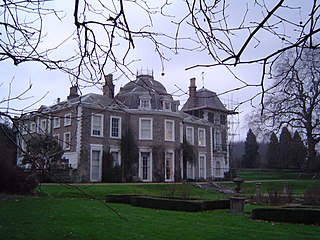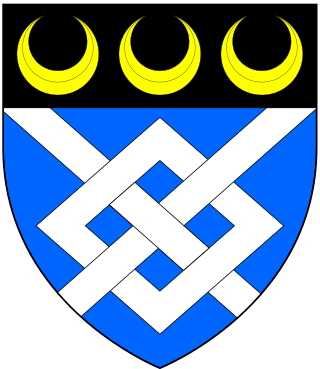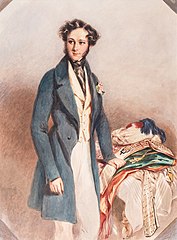
Lord Napier, of Merchistoun, is a title in the Peerage of Scotland. It was created in 1627 for Sir Archibald Napier, 1st Baronet. Earlier that year, he already held the Napier Baronetcy, of Merchistoun in the County of Midlothian, created in the Baronetage of Nova Scotia. The titles remained united until 1683, when the Baronetcy became dormant. It was revived in the early 19th century and is now held by another branch of the Napier family. Between 1683 and 1686, the Lords of Napier also held the Nicolson Baronetcy, of Carnock in the County of Stirling, and since 1725 the Scott Baronetcy, of Thirlestane in the County of Selkirk, both baronetcies created in the Baronetage of Nova Scotia. The latter one is held till today. Additionally, the tenth Lord was created Baron Ettrick, of Ettrick in the County of Selkirk in the Peerage of the United Kingdom on 16 July 1872.

Baron Northbrook, of Stratton in the County of Southampton, is a title in the Peerage of the United Kingdom. It was created in 1866 for the Liberal politician and former Chancellor of the Exchequer, Sir Francis Baring, 3rd Baronet. The holders of the barony represent the genealogically senior branch of the prominent Baring family. The name Northbrook is derived from a tithing of the local parish.

Oxon Hoath is a Grade II* listed Châteauesque-style former manor house with 73 acres of grounds at West Peckham, Kent. The spellings Oxenhoath, Oxen Hoath and Oxonhoath are common alternatives. The spelling Oxenholt was also used in the past. The manor is a former royal deer park. Oxon Hoath has been the seat of two baronetcies, and of five High Sheriffs of Kent. It has a surviving example of parterre gardens in its grounds.
There have been five creations of Fletcher baronets from 1641 to 1919, three of which are extinct. The creations of 1782 and 1796 have descended to male descendants who have changed surnames to recognise further early inheritance and are the existing Fletcher hereditary titles in the Great British baronetcy.

There have been three baronetcies created for people with the surname Hood, one in the Baronetage of Great Britain and two in the Baronetage of the United Kingdom. The first Baronet of the first creation was made Viscount Hood, while the fourth Baronet of the second creation was made Baron St Audries.
Nineteen baronetcies have been created for persons with the surname Hamilton, eight in the Baronetage of Nova Scotia, one in the Baronetage of England, five in the Baronetage of Ireland, one in the Baronetage of Great Britain and four in the Baronetage of the United Kingdom. As of 2008 two creations are extant, two are dormant, two are either extinct or dormant and twelve extinct.
There have been six baronetcies created for persons with the surname Brooke, one in the Baronetage of England, one in the Baronetage of Ireland and four in the Baronetage of the United Kingdom. As of 2015 four of the creations are extant, though one has been subsumed into a peerage.

There have been twenty one baronetcies created for persons with the surname Williams, eight in the Baronetage of England, three in the Baronetage of Great Britain and ten in the Baronetage of the United Kingdom. Only six of the creations are extant as of 2017.
There have been seven baronetcies created for persons with the surname Thompson, one in the Baronetage of England, one in the Baronetage of Great Britain and five in the Baronetage of the United Kingdom. Three of the creations are extinct while four are extant. See also Thomson baronets and Meysey-Thompson baronets.
There have been two baronetcies created for members of the Baring family, one in the Baronetage of Great Britain and one in the Baronetage of the United Kingdom.
There have been six baronetcies created for persons with the surname King, one in the Baronetage of Ireland, one in the Baronetage of Great Britain and four in the Baronetage of the United Kingdom. Three of the creations are extant as of 2007.
There have been two baronetcies created for persons with the surname Curtis, one in the Baronetage of Great Britain and one in the Baronetage of the United Kingdom. One creation is extant as of 2007.

There have been four baronetcies created for people with the surname Drake, three in the Baronetage of England and one in the Baronetage of Great Britain.

There have been two baronetcies created for the Knowles family, originally a branch of the Knollys family known as Knollys of Stanford. One is in the Baronetage of Great Britain, which is extant, and one in the Baronetage of the United Kingdom, which is extinct.
There have been two baronetcies created for persons with the surname Coghill, both in the Baronetage of Great Britain. One creation is extant as of 2008.
The Baker, later Sherston-Baker Baronetcy, of Dunstable House in Richmond in the County of Surrey, is a title in the Baronetage of Great Britain. It was created on 14 May 1796 for Robert Baker, in honour of him raising and maintaining a cavalry regiment of 500 men styled "The Richmond Rangers" for King George III. He was succeeded by his son, the second Baronet. He was a vice-admiral in the Royal Navy. The fourth Baronet was a Recorder of Helston and of Barnstaple and Bideford and a County Court judge. The fifth Baronet assumed by deed poll the additional surname of Sherston in 1923. The Baker family was settled in the Westcountry several centuries before the creation of the baronetcy. A version of the arms used by the Baker baronets is displayed on the mural monument in Dunchideock Church in Devon of Aaron Baker (1620–1683) of Bowhay in the parish of Exminster, Devon, first President of the Madras Presidency.
There have been three baronetcies created for members of the Ogilvy family, all in the Baronetage of Nova Scotia. As of 2008 one creation is extant while two are either extinct or dormant.
There have been five baronetcies created for members of Clan Ramsay, four in the Baronetage of Nova Scotia and one in the Baronetage of the United Kingdom. The baronetcy in the Baronetage of the United Kingdom is extant as of 2023.
Sir William Geary, 2nd Baronet was an English Tory politician from West Peckham in Kent. He sat in the House of Commons from 1796 to 1806 and from 1812 to 1818.
There have been three baronetcies created for persons with the surname Duncan, one in the Baronetage of Great Britain and two in the Baronetage of the United Kingdom. All three creations are extinct.









